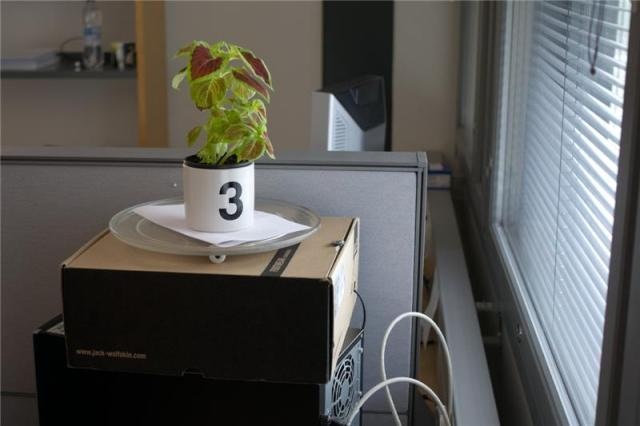Jun 23 2016
Internet of things, IoT, is a fast expanding network of consumer and industrial devices, i.e., “things”. The IoT Lab at the University of Helsinki has a growing good reputation for letting the computer science students develop smart IoT devices and services; students climb the rooftop and the result can be plants spinning in a disco.
 Plant disco. (Credit-Image by Miro Sorja)
Plant disco. (Credit-Image by Miro Sorja)
Almost anything can be connected to the Internet, from electricity meters to cars and complete houses. Internet connected things also create vast amounts of data and allow us to make use of the produced data.
“The IoT Lab is an experimental facility for supporting research and education, and fostering student creativity. Each year we are amazed by the innovative applications students create in the lab”, explains Professor Sasu Tarkoma, Head of the Department of Computer Science at the University of Helsinki.
Wellbeing plant growing with help of led lights
“We wanted some automated system to follow and manage our plants, even from abroad”, explains Santeri Paavolainen from the University of Helsinki, attending a Greenhouse course supported by the IoT Lab for students of computer science – a course which is taking place on the rooftop of a university building in Helsinki.
“So we brainstormed some ideas. Then we narrowed it a bit, thought that following the plant’s wellbeing was enough, the watering part could be made with a pump of some sort”, Paavolainen says.
Step by step, a RGB UV Smart Garden was founded. It has sensors for temperature, and light sensors with green, blue, red and UV leds sending data to storage. When a plant needs more light in the evening you can now turn the light level up with your phone.
A plant spinner
Plants grow towards the Sun, or other source of light. And as the home gardener turns his/her back to gardening duties just for a few moments or weeks, the plants might already have found their way out of the pot creeping around and robbing the gardeners of their initial visual delight.
“Our solution is very simple with a microcontroller, servo and light sensor. The design has the plant sitting on a rotating platter that can be turned to any angle driven by a servo. A light sensor gathers information on the amount of light received by the plant. A simple algorithm in the microcontroller will then rotate the plant so that in a given time frame each side of the plant will receive a similar amount of light”, explains Heikki Lindholm in the blog from the same Greenhouse course.
The result of the student’s team work is a plant spinner.
Creative Internet of Things education @UnivHelsinkiCS
Since 2010 the IoT Laboratory at the Department of Computer Science serves as a multidisciplinary learning and research “sandbox” focusing on hands-on experimentation in order to discover and demonstrate the promise of the IoT.
From the year 2010 onwards also the rooftop of the department has been a busy site for scientific experiments. The location was first used for studying whether it was possible to cool computer servers with the harsh Finnish winter air. Turned out that it was, and Mikko Pervilä defended his doctoral thesis in 2013 on data centre energy efficiency.
Now the students in the IoT lab have been able to develop and test IoT concepts with some of the latest solutions available. Furthermore, they are encouraged to turn the gathered big data into actionable data.
The Greenhouse course puts the ideas into action
The Exactum Greenhouse course is a seven week project course where students build smart IoT devices to help maintaining living plants. Students develop both software and hardware - using sensors, servo motors and microcontrollers such as Arduino and Raspberry Pi.
The plant spinner is one outcome from the work done there, others can be something like the plant disco. The students work in teams designing and building an IoT monitoring system and a related reporting dashboard for the Exactum Greenhouse.
Everybody can possess an IoT Hub
In the world of IoT, all things in our environment create and provide data. To be able to disseminate, analyze and use this data, we need to have open interface platforms, IoT Hubs. IoT Hubs gather data from diverse sources, applications and services. Each individual can possess an IoT Hub, which organizes the information as preferred. It allows the user to access the desired information in a secure manner and without having to release your personal data.
“The IoT field is large and solutions in it have to be scalable and no laboratory by itself can do it alone. Cooperation with the industry and academia is needed”, says PhD Samu Varjonen, one of the leaders at the Exactum Greenhouse course